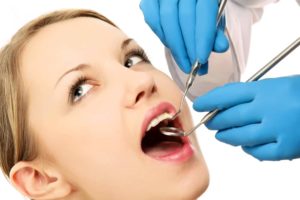
Is it time to schedule a dental checkup? Besides thoroughly cleaning your teeth of plaque and tartar, your regular appointments allow your dentist to check up on the health of your teeth and gums and inspect for signs of trouble. If trouble is found, then your dentist can recommend a treatment plan to address it early, before your smile suffers extensive dental damage or infection.
Brushing and flossing your teeth at least twice a day is fairly easy, and it’s important to the continued good health of your teeth and gums. However, the simple act at home is not enough to maintain your healthy smile in the long run. All patients, regardless of age, should attend regular checkup and cleaning appointments, usually no more than six months apart.
The Reason Behind Scheduling Regular Dental Checkups
A dental checkup is a routine examination that involves a thorough visual inspection, and in some cases, the use of digital imaging equipment, like X-rays. Because many of the most common dental problems begin discreetly, regular checkups offer the best chance at protecting your smile from the development of dental health issues.
In addition to cavities, gum disease, and damage to one or more teeth, your dentist will also look for signs of oral cancer, such as lesions, open sores, and other abnormalities. Like other conditions, oral cancer is most effectively treated when detected and addressed in its earliest stages.
Why Checkups and Cleanings Are Crucial to Oral Health
Dental hygiene can help keep your teeth and gums in great shape, but they’re rarely enough to completely prevent plaque buildup. To remove hardened plaque, known as tartar, from the surface of teeth, routine professional cleanings are required.
In fact, only a professional cleaning can remove tartar, once it has reached this calcified state. Without prompt removal, this bacteria buildup can be responsible for causing cavities, gum disease, and a host of other oral health threats as well.
Oral Cancer
Your tongue is the most common place for oral cancer to present itself. Any pathology on the tongue should be investigated thoroughly for this reason. When you go to the dentist for an oral examination, your tongue is examined too.
Examination of the Tongue
Your tongue should be examined in the following ways:
Lateral Border:
This is the most common place to find oral cancer. The lateral border is the side edge of your tongue. Your dentist should grasp the tip of your tongue and roll it over to each side to observe the lateral borders. Next your dentist should use the mirror to examine the posterior (back) lateral borders as well.
Ventral Surface:
Your dentist should ask you to raise your tongue to the roof of your mouth to observe the bottom (ventral surface). The bottom of your tongue should be pink and symmetrical in shape with a smooth surface.
Finally, your dentist should palpate your entire tongue between the finger and thumb of one hand. Your tongue should feel soft and resilient with no masses.
Because your tongue can relay important information to your dentist about your oral health and your overall health, your dentist probably pays more attention to your tongue than you do.
Why Early Detection Matters
Dental conditions are progressive – the longer they remain, the more damage they can cause to your teeth, gums, and oral structures. Early detection through routine dental checkups helps you avoid the need for extensive restorative treatment by preventing the development or spread of harmful dental conditions. In the case of oral cancer, early detection significantly raises the chances of successful treatment, and reduces the risks of more severe illness or death.
Dr Fondriest is a Nationally recognized and highly sought after cosmetic dentist. He serves clients from throughout the United States
